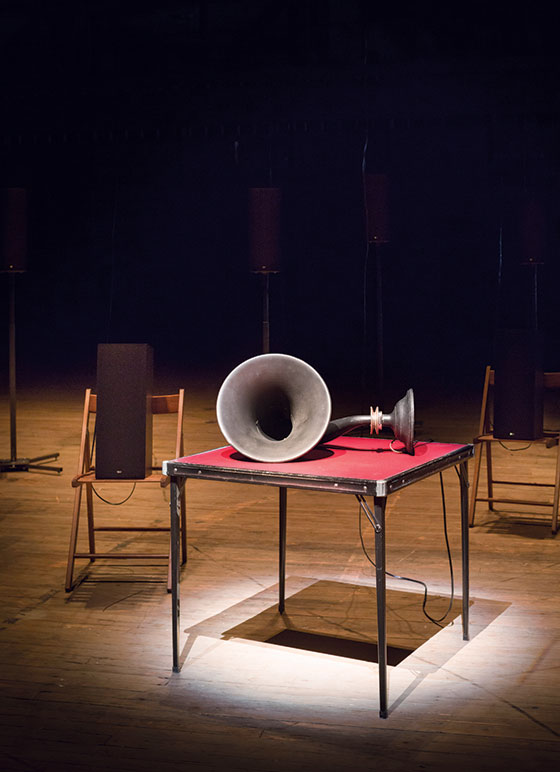
When you first hear footfalls reverberating in the darkened drill hall of the Park Avenue Armory, it’s difficult to know whether they’re yours or someone else’s, if they’re distant or close, or whether they belong to anyone at all. The eyes can make out only a spare apparatus contained in an intimate pool of light: a few rows of folding chairs, an old gramophone horn lying on its side on a metal table, like an attic find for sale in a church basement. A forest of speakers recedes into the vastness all around.
Those footsteps are the prelude to The Murder of Crows, a half-hour sound installation by Janet Cardiff and George Bures Miller that envelops the audience in a seductive nightmare—Cardiff’s, presumably, since it is her dry, wry murmur we hear narrating a series of flamboyantly gory scenes. (“And the cats got all ground up, and then the blood was pouring out, and then another machine fed babies into it.”) If the experience of listening in on these dreams is electrifying rather than harrowing, it’s because Cardiff and Bures Miller create a beguiling aural world out of those grim projections of the mind.
The two married artists don’t describe themselves as composers, yet this is a deeply musical work. (It’s part of the Mostly Mozart Festival, and it ties in loosely with this year’s ornithological theme.) Singers, choirs, an orchestra, guitars, and Tibetan nuns all participate, sounding vivid, present, and all around, like creatures in a forest. But they are ghosts, their voices channeled through inanimate objects singing in the dark. Snatches of music (some of it by Tilman Ritter and several other collaborators) come fleetingly into focus, yielding surreal sonic images that melt away before you can pin down their meaning: a cello ensemble on a windy cliff, perhaps; a Russian Army chorus thronging around your head. Each section feels perfectly incongruous, though with what it’s hard to say, since the whole tapestry is woven from disjunct sounds.
Cardiff and Bures Miller are not above cheap thrills. Hollywood long ago discovered the chilling possibilities of footsteps, cawing crows, and whining motors, and how to imbue a sound with drama just by haloing it with a slight artificial echo. Here, too, ordinary noises—dripping water (or is it blood?), a saw grinding relentlessly through wood (or maybe bone)—acquire ominous resonance. But what keeps The Murder of Crows from becoming hackneyed is that it distills the horror-film soundtrack into a textured mood piece in which buildup and revelation are intertwined. Ghoulish humor helps. “Where is my leg, where has it gone?” a soprano sings primly, echoed by an operetta chorus.
Cardiff and Bures Miller have found a way to reproduce acoustically the jagged dislocations of a dream. Under normal circumstances, your ears can be relied on to tell your brain how big a space you’re in, and what its surfaces are. Think how disturbing it would be to walk into a cozy, carpeted bedroom and hear a cathedral echo. Here, as 98 speakers spray the hall with sounds, the space seems to compress and expand, breathing like a great invisible lung. The surf roars at your shoulder, then recedes into the distance. A faucet drips nearby. Indoors and out seem to be waging a battle for control of your perceptions, and there is no way to resist. For that reason, even more than because of the unsettling vignettes, it’s probably best to leave several hours of daylight between The Murder of Crows and bedtime, to prevent the work’s dream world from infiltrating yours.
The Murder of Crows
By Janet Cardiff and George Bures Miller.
At the Park Avenue Armory through September 9.
